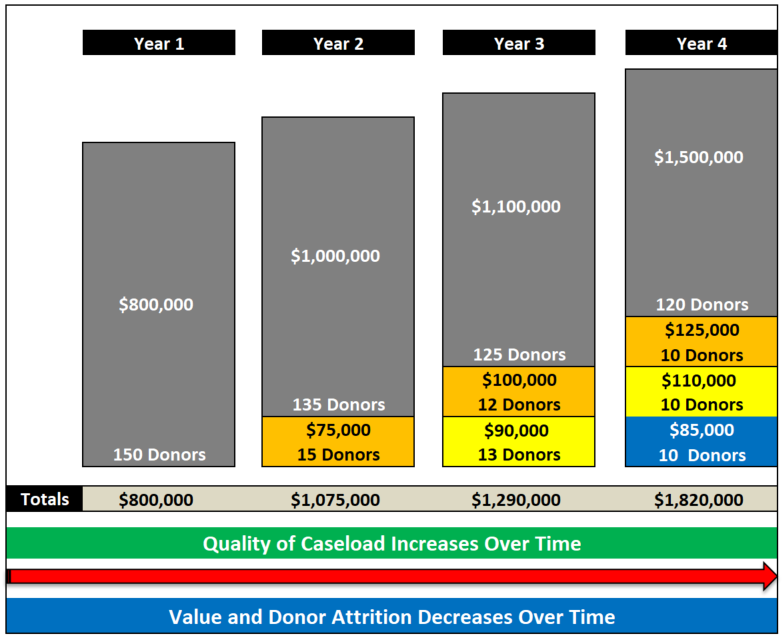 “Jeff, I’ve been thinking… what would it take to get us to $100 million in revenue from our major gift team?”
“Jeff, I’ve been thinking… what would it take to get us to $100 million in revenue from our major gift team?”
This was both frightening and exciting to hear, all at the same time. The back story is that one of our client organizations which has “grown up” using direct-response fundraising as a way to raise money and increase their donor file was now wanting to turn to major gifts as a primary source of new revenue.
Yes! Good for them.
Many non-profits in their situation continue to rely on direct-response fundraising to keep filling up the bucket. The problem is that the bucket has ever-increasing holes in it; donors are leaking out, and it’s becoming costlier to keep the bucket full.
So, many are finally turning to focus on their major gift program. That’s a good thing. The not-so-good thing is that they still have a direct-response mentality for how long it takes to really see the results.
You see, in direct-response fundraising, you realize a return almost immediately. Not so with major gifts. It takes a good 18-24 months to start seeing real growth. Beyond that, you really start to see revenue take off.
But many non-profits never get that far because they don’t have a vision, and they get impatient and frustrated when they don’t see massive gains in revenue in 6 to 12 months.
Our belief is that you need a five-year revenue vision for your caseload in which you can set the expectations of all who are tracking progress, and you can inspire your team for what is possible. (Read my previous post in this 2-part series for more on getting a vision.)
How do you go about setting this five-year vision? Here are two ideas that help set a vision for your individual caseload and for specific donors in that caseload who can make a transformational gift:
Your Caseload
To figure out your own caseload, you have to first know how many qualified donors you currently have in your portfolio. If you have less than 150, but you have a “caseload pool” of donors waiting to be qualified, you should figure that by the end of year one (of your five-year revenue forecast) you will need to qualify enough donors to end with 150.
If you already have 150, you just need to focus on increasing the revenue per donor each year.
Remember, the whole idea is to increase the value of your caseload over time, because this is where net revenue growth comes from. Here is how you do it – it’s both a science and an art:
- Take the total revenue in your caseload divided by total number of donors. That gives you the baseline revenue per donor. This is the “science.”
- Now the art part: if you already have 150 donors, increase the percentage of year 1 over current by 25%, Year 2 by 20% over year 1, Year 3 by 15% over year 2, Year 4 by 10% over year 3 and Year 5, 5% over year 4. Is that aggressive enough for you? Should it be higher? Check out the graphic below that illustrates how a file can grow over time.
 In this particular scenario, this caseload grew 123% in 4 years. This was due to two major factors: the average gift per donor went up, and non-performing donors were replaced by new donors. This is to just to help illustrate for you how you can project growth in your caseload.
In this particular scenario, this caseload grew 123% in 4 years. This was due to two major factors: the average gift per donor went up, and non-performing donors were replaced by new donors. This is to just to help illustrate for you how you can project growth in your caseload.
- If you don’t have 150 donors, you’ll want to add them from your potential pool. (You’ll also need to replace donors each year as they stop giving or their engagement or potential goes down.) Then in years 2-5, increase the percentage of revenue per donor each year. Again, there is an art and a science to this. You want to be reasonable yet aggressive, as this is setting the vision for the future.
Transformational Donors
Finally, the last piece I want to discuss is creating a vision for those 2 to 3 donors in your portfolio that could give a transformational gift. They are in your caseload. Here is what to do:
- Identify those 2-3 (maybe more, depending on your caseload) that have the capacity to give 6, 7 or even 8-figure gifts. Look at the total giving, capacity and other info you have on those donors.
- Now, do you know what their passions and interests are? If not, it is key that you figure this out. No one is going to give you a seven-figure gift if you don’t match their passions and interests with a specific program from your organization.
- Find those projects and programs that could accept a seven-figure gift, and match them to your caseload donor. Many times, non-profits have not identified them. To create a vision for the donor, the organization has to have a vision. (Learn more about packaging programs into donor offers here.)
- Okay, if you know the passion and interests of the donors, and you have the project identified, create a plan over the next 18-36 months to lead that donor to a transformational gift. This requires a ton of relationship building in order for you and your organization to gain the donor’s trust.
- This also means that you are asking for incrementally higher gifts over this time period. Don’t make the mistake of waiting three years to ask for that one transformational gift. Rome wasn’t built in a day.
This is how you can set a long-term vision of growth for your caseload and for a few transformational donors.
If you’d like help, we can do one of our free major donor assessments on your data file and help you build a five-year revenue projection like we have outlined. Whether we do an assessment and plan like this, or you do it on your own, the important thing is that creating a long-term vision forces you to create plans and strategies today that can lead you to accomplish it.
Look beyond tomorrow so you know what to do today.
Jeff
Read Part 1 of this series: click here






0 Comments